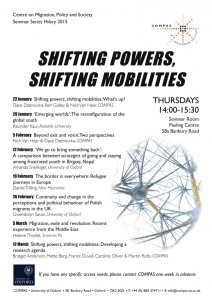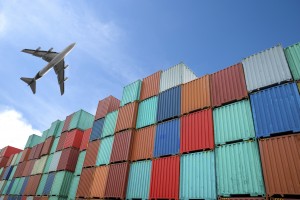By: Kareem Rabie, Senior Researcher and Marie Curie Fellow
 This term, Dace Dzenovska, Nick Van Hear, and Ben Gidley have organized events around the themes of “shifting powers” and shifting mobilities.” Themes that build upon last term’s sited, urban focus to questions of shifting spatial and political dynamics in “arrival cities.” The central questions they ask are about geopolitical shifts in power, and in social and spatial forms of mobility; and the three are working towards a research agenda on migration attentive to wider contexts of geopolitics and geoeconomics.
This term, Dace Dzenovska, Nick Van Hear, and Ben Gidley have organized events around the themes of “shifting powers” and shifting mobilities.” Themes that build upon last term’s sited, urban focus to questions of shifting spatial and political dynamics in “arrival cities.” The central questions they ask are about geopolitical shifts in power, and in social and spatial forms of mobility; and the three are working towards a research agenda on migration attentive to wider contexts of geopolitics and geoeconomics.
As the Marie Curie postdoctoral fellow at COMPAS, I’ve been thinking with and across migration studies. As an anthropologist and human geographer working in Palestine and Israel, the question becomes less about mobility as a general phenomenon, but what it means to talk about mobility in a context of immobility. How specifically is it enabled and disabled? Where, for whom, for what, and at what geographical scale? In an environment that seems at different times, in different places, and at different scales, to be either highly malleable or completely static and circumscribed (not to mention for different authors), what does movement mean?
Capital mobility
In my first project, I studied the emergence of privatized governance in Palestine through one of the marquee developments, Rawabi, a “planned” town being built north of Ramallah for 40,000 “middle class” Palestinians, and costing around $1 billion, mostly from the Sovereign Wealth Fund of Qatar. It is a massive project, physically fixed in place. An official municipality, the new town will maintain industries in IT, outsourcing, and other sectors that require the free movement of capital and information, but not goods or people. Developers aim to engineer not only a new, outward-looking economic sector but, concomitantly cultivate a middle class living and working, and debt financing new homes there.
Capital comes in and is fixed, and types of intra-West Bank and class mobility form around it. In the context of both occupation and global political economy, local industry is deemphasized, and labor and work are increasingly oriented towards those fields that can exist despite restriction on the movement of people and goods. But something is nevertheless emerging.
Capital and information can cross borders, but what kinds of people and goods are mobile?
I am beginning a second project on new geographies of regional and global trade in Palestine, and on the social aspects of commodity chains, that I hope will speak to questions of shifting contexts and forms of mobility. Today there is a close link between businessmen in Hebron—formerly the hub of small production in the West Bank and perhaps the most highly militarized city there today—and factory owners in China. The Hebron Chamber of Commerce monitors this link, but there have been no formal academic or policy studies of it to date. There is, however, plenty of anecdotal evidence, and people talk about it all over the West Bank. News reports on the Hebron industry mention it, but do not elaborate. They describe family businesses destroyed by “cheap Chinese imports” and bemoan the lack of production in Palestine in general, especially of Palestinian heritage items like the kuffieh.
 Scraps of information emerge in this handful of stories: a Palestinian importer spends half of his year in China. He says that at first it was uncomfortable, but now there are many Arabs, and “translators and Syrian and Lebanese food.” Another has business cards printed in Mandarin. Chinese diplomats are said to routinely travel from Israel to Hebron to give out visas. A 2008 New York Times piece describes Yiwu, “a buzzing trading spot thanks to the influx of Middle Eastern money…a hub for selling made-in-China Arabic products, like fashion clothing and religious artifacts.” The article quotes the head of Palestinian-Chinese trade relations at the Palestinian embassy in Beijing, who estimates Palestinian imports of Chinese goods at $2 billion annually, through direct trade or through Israel. He also suggests that more than 200 Palestinian businessmen have settled in China over the past decade in addition to thousands of other Palestinian and Arab businessmen who travel there frequently.
Scraps of information emerge in this handful of stories: a Palestinian importer spends half of his year in China. He says that at first it was uncomfortable, but now there are many Arabs, and “translators and Syrian and Lebanese food.” Another has business cards printed in Mandarin. Chinese diplomats are said to routinely travel from Israel to Hebron to give out visas. A 2008 New York Times piece describes Yiwu, “a buzzing trading spot thanks to the influx of Middle Eastern money…a hub for selling made-in-China Arabic products, like fashion clothing and religious artifacts.” The article quotes the head of Palestinian-Chinese trade relations at the Palestinian embassy in Beijing, who estimates Palestinian imports of Chinese goods at $2 billion annually, through direct trade or through Israel. He also suggests that more than 200 Palestinian businessmen have settled in China over the past decade in addition to thousands of other Palestinian and Arab businessmen who travel there frequently.
In China, official policy since 1978 been geared towards opening China’s labor and consumer markets. Like elsewhere under global capitalism, China seeks new markets. China and Palestine have seen ongoing changes from a revolutionary politics and political economy, to one somewhat less so, and have experienced their own versions of global and transnational historical shifts. From Bandung to neoliberalism, Maoism to “capitalism with Chinese characteristics,” and from the PLO to the PA, this is an example of what south-south ties look like today. Phenomena, links, and histories are cumulative. There are important resonances between Palestinian and Chinese structural and social experiences of change, and the multitude of links between the two is a potentially rich topic for study, and potentially helps illuminate dynamics of movement and global links that may or may not include large numbers of people, but are a fundamental part of the shifting context for global mobility.
Circulation
In anthropology we are necessarily limited by what we can see, but by following relationships we can connect people and the settings and contexts of which they are a part. In focusing on circulation of capital, goods, and people, on the relationships between money and knowledge, we often cannot see where money goes, to whom, and in what quantities. But we can try to understand the wider processes, ideas, ideologies, practices, and ramifications of circulation; and how they are all materially and immaterially productive.
Capitalism is a process of circulation; not everyone is involved in production, but most everyone is implicated in circulation. Circulation of people, capital, and commodity can help illuminate the human, relational, and social aspects of structural issues and phenomena, on relationships, forms of capital and power that move across and circulate to produce social space.
Transactions and financial relationships link people, institutions, and organizations globally; ethnography can tell us about those links, and about the lived experiences of markets, politics, and economies at multiple geographic scales. And mobility may mean things beyond the movement of people. A focus on political economic links, and explicitly on multiple forms of circulation, may speak directly to questions of migration and mobility by parsing what it means for different types of populations, in terms of different forms of fixity and relationships to home in shifting political and economic contexts.